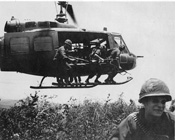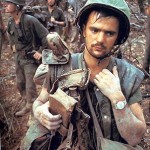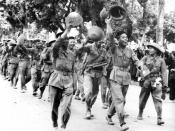However, as soon it was announced that we would be leaving Afghanistan, the Afghan military and police forces seemed to have started planning their exodus from the scene too. It appears that the old adage about leading a horse to water but not being able to make them drink is applies to the Afghans. We can train them. We can equip them. We can hold their hand (metaphorically speaking), but, ultimately, we couldn't give them the will to fight for their own country. We couldn't instill willpower.
Instead, the Afghan military and police (or security forces), simply threw down their weapons, changed clothes, and walked (or ran) away, leaving the Taliban to walk in and take whatever they wanted, which, in this case, included helicopters, Humvees , tanks, drones, rockets, artillery, and thousands of assault rifles, small arms, Kevlar vests, communication equipment, medical supplies, and millions of rounds of ammo. That doesn't include "brick and mortar" assets like buildings, roads, runways, and the necessary infrastructure to set up either a top class military or government.
Meanwhile, in the capital of Kabul, the government, known for its corruption, and which we "helped" to install, packed its bags, looted what they could, and high tailed it out of town in private jets as thousands of Afghans do everything in their power to board U.S. and allied transports out of the country while risking their lives in the process as the Taliban's noose around the airport tightens.
The whole scenario is reminiscent to older Americans of the collapse of South Vietnam and the ultimate Fall of Saigon, complete with images of helicopters evacuating embassy personnel from roof tops but there are some notable differences which deserve exploring.
America seemed to stumble into Vietnam, unlike Afghanistan, which came as a direct response to the cowardly 9/11 attacks by Al Qaeda and its leader, Osama bin Laden. In the case of Vietnam, a territorial "possession" of an imperial France, it was an ideological war to stop Communism and potential new front against the USSR and China.
The Vietnamese People had been waging a guerilla war for independence against a imperial France since around 1887, when it was forcefully incorporated into French Indochina, which included Laos, Cambodia, and Thailand, which didn't end until 1954, with a brief inter lieu of Imperial Japanese occupation from 1940 to 1945.After the war ended in 1945, France reneged on its promise of independence a second time (claiming that the Vietnamese weren't "ready" to govern their country), but it was exhausted and broke from the war, as were the British. The USSR and China began sending weapons and supplies to aid Viet Minh, as the nationals, led by Ho Chi Minh, were called by 1950. President Eisenhower, fearful of the so-called "domino" effect of Communism, sends "advisors" to aid the French in response.
Following their defeat at Dien Bien Phu in 1953 the French threw in the towel, and withdrew (it was 1947 for India when Britain agreed to India's independence). In 1954, Eisenhower used America's new role as a global leader at the Geneva Conference to publicly support a democrat republican South Vietnam, while the north was under the control of the Communist. The conference divided the country at a demilitarized 17th Parallel with a communist North and republic South.
As an aside, in 1919, following the end of WWI, the Vietnamese sent a delegation to the Versailles Conference to ask France, and the nations attending, to add them in obtaining independence (and to expose France's pre-war promise of independence). Instead, they were ignored and ultimately walked out. In 1945, Ho Chi Minh sent a letter to President Truman asking him to support their demand for self-determination. Their letter went unanswered.
It's worth noting that North Vietnam, which called itself the Democratic Republic of Vietnam, was Communist, had been unaligned with the USSR and China prior to 1954. After the U.S. officially threw its support behind South Vietnam, known as the Republic of Vietnam, the North officially aligned with Soviet Russia and China in response to offset the weight of the U.S. economically and militarily.
The French had lost 75,581 military personnel. 64,124 were wounded, and around 40,000 became POWs. The insurgent Viet Minh lost approximated 191,605. Financially, the war cost three billion francs, of which the U.S. picked up 30% of the tab as part of its war against the spread of Communism.Up to 1954, the war was largely seen as a war of independence from Imperial France. After that, it became a civil war. The U.S. refused to sign the Geneva Accords and demanded an election supervised by the UN, along with the South Vietnamese Government. An election as a peaceful resolution to the current, and possible future hostilities in Vietnam, however, the President of South Vietnam, Ngo Dinh Diem, refused.
With a propped up government in the south, America found itself involved in a civil war, whether it wanted to be or not by 1955. In 1959, the North began a guerilla campaign in against the Saigon Government in the south. In 1960, President John Kennedy authorized additional advisors to be sent, including 400 specially trained Green Berets along with the use of "Agent Orange".
In 1963, Kennedy approved the assassination of South Vietnamese President Ngo Dinh Diem, who was highly unpopular and openly corrupt, and the overthrow of his government which was carried out by the ARVN (Army of the Republic of Vietnam) with aid from the CIA. By this time, U.S. troop levels had reached 16,000. He was replaced by General Duong Van Minh (a military junta continued to control the government until its fall in 1975). America's role in Vietnam's civil war increased under President Lyndon B Johnson, following the assassination of John Kennedy in 1963.
1964 marked the jumping off point in the war. In what became known as the "Gulf of Tonkin Incident", the USS Maddox reported coming under attack from three North Vietnamese torpedo boats for allegedly violating their territorial water (the captain of the Maddox maintained they were in international waters). The Maddox returned fire after a warning shot failed. Planes from the USS Ticonderoga joined the fray along with the USS Turner Joy.
It was reported that one torpedo boat was sunk and the other two were damaged (one heavily). Later, a second attack was reported with the Maddox and Turner Joy firing at radar indicated targets. No debris or bodies were found and it was determined that a second attack did not occur. Following the incident, President Johnson increased troop levels to just over 23,000. By 1967, that number had reached 485,600.Despite official claims that the war was virtually won and the North was on the ropes, 1968 saw the bitter fight for Khe Sanh, the My Lai Massacre, and the Tet Offensive, along with the assassinations of Dr Martin Luther King and Senator Bobby Kennedy, both of whom opposed the war. Support for the war at home all but evaporated . Accepting that reelection was all but impossible, Johnson announced on national television that he would not run for president again.
Richard Nixon, however, saw an opportunity, and despite running (and winning) on promises to bring U.S. involvement to end, saw American troops numbers reach 536,100. The next few years saw brutal fighting while American's saw nightly on television the mounting futility of the war. Meanwhile, Nixon disconnected the dollar from the gold standard, resulting in rising inflation and an increase in prices and unemployment. A new economic term, "stagnation" was introduced to the American public.
In 1972, while the U.S. increased its bombing of the North, troops were reduced down to 24,000 amid negotiations with the North. In 1973, the draft ends as America "officially" enters a recession (the expression at the time was that "a recession in Washington and a depression in the heartland") and OPEC triggers an oil embargo. America's attention to the war was increasingly being diverted.
1975 saw the last American troops, embassy personnel, members of the South Vietnamese Government evacuated, and ordinary civilians jumping fences, breaking through gates, and do everything possible to board U.S. planes and helicopters, often from roof tops of official buildings. Meanwhile, Soviet made tanks rumbled into Saigon as North Vietnamese troops spread out everywhere. These are images people today recall when comparing our exit from Kabul to Saigon.
The war resulted in 58,220 men and women dead or missing. For those who care about such things, the majority were white, 49,830. 7,243 were black. 349 were Hispanic, 226 were Native American, and 139 were Asian. Most were men, or to be more honest, young men; boys really. Drafted at 18, some weren't old enough to drink or vote and have a say as to what became of them and their lives.Financially, the war cost American Taxpayers $168 billion dollars (that's equivalent to $1 trillion in 2019 dollars). Of course, that doesn't include the millions in military equipment left behind, nor does it take into consideration the dozens of planes and helicopters dumped overboard on Navy carriers to make room for the hundreds of refugees.
The cost of the war in Afghanistan is still be tabulated, but estimates are over $2.231 trillion. Even the final count of the dead and wounded remains unfinished. We can say that 7,067 died at as direct result of the war, which doesn't include our coalition partners, whose deaths number over 110,000. It also doesn't include the 30,177 service men and women who lost their lives to fighting personal battles as a result of suicide. We may never know that final figure. We are still adding to those numbers daily from Vietnam veterans. It also doesn't take into accounted the wounded or disabled, which is in the thousands.
The world as well as many at home saw Vietnam as America's first military defeat. Some are starting to claim that Afghanistan is our second. However, there are some key differences. Vietnam was in truth a civil war that we had no business in, but the mindset of the time was one of stopping the expanding influence of Communism.
Western foreign policy was built on the premise of the so-called "domino effect". As one nation fell to Communism, so would its neighbor and so on. Well, it never really happened. Ultimately, the USSR fell. Now former Communist nations are largely democratic and engage in capitalism, albeit in a limited form, including a united Vietnam, Russia, and China.
We willingly failed to see Vietnam for the civil war it was, and chose to see it as stopping the spread of Communism in Southeast Asia. We assumed that everyone wanted to be like America. In that we were wrong. Not everyone wants or is ready for democracy or capitalism. We have repeatedly failed in that regard.Afghanistan was different. It was run by a religiously radical Taliban who protected those responsible for the cowardly attacks of 9/11. Our goal was to capture or kill those responsible. It that we were successful. Al Qaeda was decimated. It's leader, Osama bin Laden killed along with most of its leadership. The Taliban too removed from power and a more modern government installed. However, as in Vietnam, it provided to be largely inept and corrupt.
In both wars, politicians increasingly dictated the course of the war. In Vietnam, it was more direct with politicians second guessing generals. In Afghanistan, it was the military leadership which had become more political. Certainly, they were much more media savvy. Public perception made our returning Vietnam vets into "baby killers" thanks to the media. Today, thankfully, those veterans, as well as those returning from Iraq and Afghanistan are much more respected and appreciated.
For our rivals, which includes China, Afghanistan represents a second defeat. Naturally, the Taliban, along with Iran and militant Islam, see it as a victory, not just against the "Great Satan", but for their radical ideology, whose ranks are sure to growth along with their boldness. Whether the world, and more importantly, average Americans, see it as a defeat or a victory, or something in between remains to be seen.
Vietnam War Facts, Costs, and Timeline
The Assassination of Ngo Dinh Diem



_underway_at_sea%2C_circa_the_early_1960s_(NH_97900).jpg/180px-USS_Maddox_(DD-731)_underway_at_sea%2C_circa_the_early_1960s_(NH_97900).jpg)


No comments:
Post a Comment